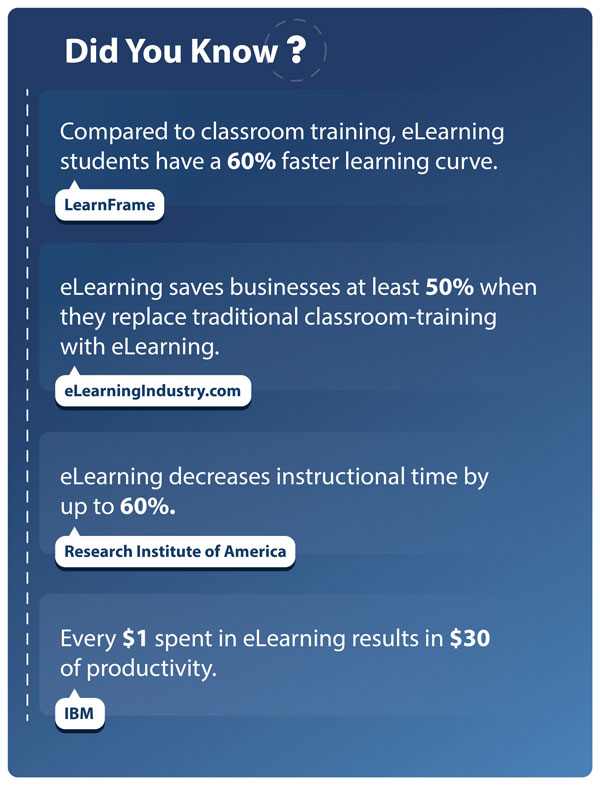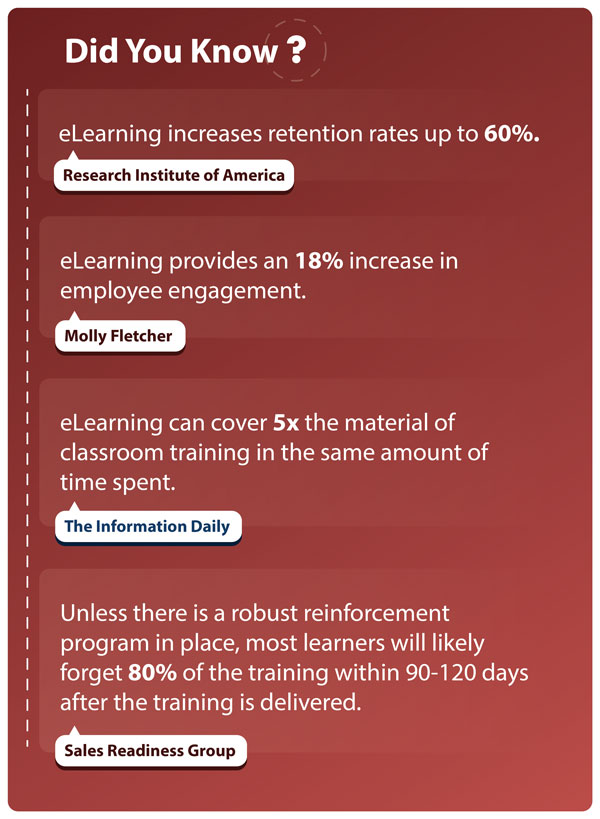Classroom, or on-line?
If you are spending time here, it’s likely you’re thinking about one of the big questions for a sales training plan. Classroom, or on-line?
Before you reach a conclusion, you will likely also ask “how effective is eLearning?” And once you get the answer to that, the next obvious question is “why is eLearning so effective?”
There are many studies, both academic and industry that provide data, both qualitative and quantitative, that shows the dramatic advantage of eLearning compared to an old-fashion classroom “experience”.
eLearning, by its nature supports the organization’s goals
- Reduced training costs – No travel, no hotels, no time out of the field. Add it up. A two day course plus travel to/from. How much productivity have you lost. What are the direct and indirect costs?
- Decreased material costs – No setup, no logistics, no drinks and cookies. How many people have to support a classroom session, what materials are tied up?
- Increased productivity – Train in off peak hours, maintain sales campaign momentum. There are always customer calls, always fires to be fought. This is the life of a sales person. With eLearning you can start and stop, but your sales don’t.
- Standardization – Consistent quality and content. All customer facing team members align around a common sales lexicon. How hard is it to get executives, or marketing, or inside sales or field support in to the classroom so they can be ‘on the same page’? It doesn’t happen. With eLearning, it’s possible, for the first time.
eLearning Supports the Learner’s Development
- Improved retention – eLearning can have a greater emotional impact on the learner. audio, visual, Kinesthetic learning can all be taxed in ways that aren’t practical in the classroom.
- Freedom to fail – Exploring different ideas, making mistakes, ‘getting it wrong’ is painless. With eLearning you can fail without fear. Worst case, you can always start over. Something you can’t always do in class.
- Real-time access – No constraint due to instructors or attendees schedule. eLearning is available 24/7
Learn like a pilot, retain like a pilot
Total-Selling has been designed to use the same six learning principles used to teach pilots.
- Effect – when an attendee has a positive emotional experience, they will be motivated to learn. So we make sure that attendees will frequently learn new materials and explain ‘how’ to use the techniques in real life scenarios.
- Primacy – what an attendee hears first has the greatest impact. So we make sure to provide attendees with a solid building block foundation of the best sales practices.
- Intensity – the more realistic the training, the greater the impact. So we use a teaching flow of information, realistic scenarios and quizzes to tax our attendees and engage them in the learning experience.
- Recency – when something is learned in the distant past, it is inevitable that part or all of that learning will be forgotten. So we re-visit topics from time to time throughout different modules to develop longer term retention and understanding.
- Exercise – when attendees put in to practice what they have learned it becomes ‘real’. Total-Selling eLearning exercises our attendees in a number of ways. We use realistic sales scenarios and quizzes during courses. We provide a coaching framework for managers to help put in to practice the newly learned skills.
- Readiness – is the attendee ready and prepared to learn? Picking the time that suits them and an experience that is informative and fulfilling ensures sales people are ‘Ready’. eLearning by it’s very nature is undertaken at a time of the attendees choosing. They will naturally be ready and focused. And how much time do you really concentrate during two days in a classroom?


